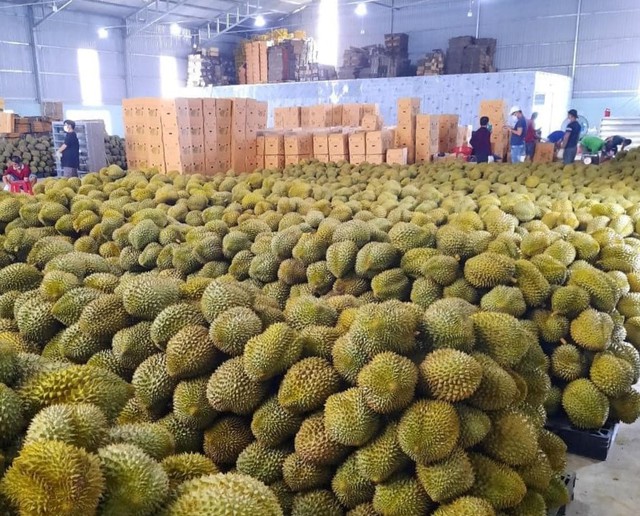Vietnam sees many opportunities to promote fruit, vegetable exports to China
Việt Nam has more opportunities to boost fruit and vegetable exports to China this year due to signing more protocols to permit official exports of fruits and vegetables to this neighbouring market.
 |
|
In 2023, durian surpassed dragon fruit to become the product with the highest export value. — Photo chinhphu.vn |
HÀ NỘI — Việt Nam has more opportunities to boost fruit and vegetable exports to China this year due to signing more protocols to permit official exports of fruits and vegetables to this neighbouring market.
At the end of 2023, Việt Nam and China signed a protocol on plant quarantine requirements for fresh watermelons exported from Việt Nam to China.
Đặng Phúc Nguyên, general secretary of the Việt Nam Fruit and Vegetable Association, said this protocol would be an important step to open up more opportunities for businesses and farmers growing watermelon in Việt Nam.
This protocol is expected to help Việt Nam's watermelon exports double next year. Accordingly, inspection of this fruit at the border gates will be much faster. China customs will reduce the frequency of inspection to only 2-3 per cent of the export batches, so there will no longer be watermelon congestion during the peak season like during the Tết holiday. Besides that, the export price of this fruit will also be more stable.
In the first 10 months of 2023, Việt Nam's watermelon export turnover to China reached US$44 million, an increase of 162 per cent over the same period last year. It is forecast that watermelon exports to this market could reach more than $50 million in 2024, said Nguyên.
One year ago, Việt Nam and China also signed a protocol on the export of fresh bananas from Việt Nam to China. According to the Import-Export Department, that protocol has created significant increase in Vietnamese bananas exported to China.
In the first 10 months of 2023, Việt Nam was the second largest supplier of bananas to China. China Customs Authority's statistics showed that during the first 10 months, Vietnamese bananas imported into China reached 412,000 tonnes, an increase of 2.3 per cent over the same period in 2022.
Meanwhile, according to Việt Nam's General Department of Customs, in the first 11 months of 2023, Việt Nam's total fruit and vegetable exports reached $5.19 billion, up 70.3 per cent over the same period last year.
China was still the largest market for Việt Nam's fruit and vegetable exports in the first 11 months of 2023 with a value of $3.4 billion, an increase of 149 per cent over the same period last year.
In terms of products, in 2023, durian surpassed dragon fruit to become the product with the highest export value of $2.2 billion, five times higher than that of 2022.
Among the top durian exporters, Chánh Thu Fruit Import-Export Ltd, Co also had a successful year with the Chinese market.
Ngô Tường Vy, general director of Chánh Thu, said durian was the company's main export product in 2023, contributing to doubling revenue from 2022.
Meanwhile, Nguyễn Đình Tùng, the general director of Vina T&T Group Import-Export Company, said that in 2023, Chinese partners ordered 1,500 containers of durian, but the company could only meet 30 per cent of the order due to lack of supply.
In the first 10 months of 2023, Vina T&T's fruit exports to China increased by 70 per cent over the same period, accounting for 35 per cent of revenue and far surpassing fruit exports to the US and Japanese markets, Tùng said.
Now, Vina T&T has a plan to expand its market share in China, according to Tùng. With huge demand from the market of 1.4 billion people, Việt Nam's durian industry is believed to still have a lot of potential in exporting this fruit. The market share of Vietnamese durian in China could be at 40 per cent in the next five years.
Việt Nam has 14 agricultural products with permission to export to China, including bird's nests and products from bird's nests, sweet potatoes, dragon fruit, longan, rambutan, mango, jackfruit, watermelon, banana, mangosteen, black jelly, lychee, passion fruit and durian.
Currently, the Ministry of Agriculture and Rural Development is coordinating with the General Administration of Customs of China (GACC) to complete documents for six kinds of citrus fruit, coconut, frozen durian, chilli, medicinal herbs and wild-caught seafood.
However, the challenge for domestic businesses and farmers is to comply with growing areas, packaging facilities, food hygiene and safety, plant quarantine, and all technical requirements.
Ngô Xuân Nam, Deputy Director of the Việt Nam Sanitary and Phytosanitary Notification Authority and Enquiry Point (Việt Nam SPS), said that only organisations with systematic production models could export to many countries, not only to China.
To maintain export markets for Vietnamese fruits, the Ministry of Agriculture and Rural Development has promoted monitoring coded growing areas and packaging facilities to meet plant quarantine and food safety requirements specified in the protocols.








